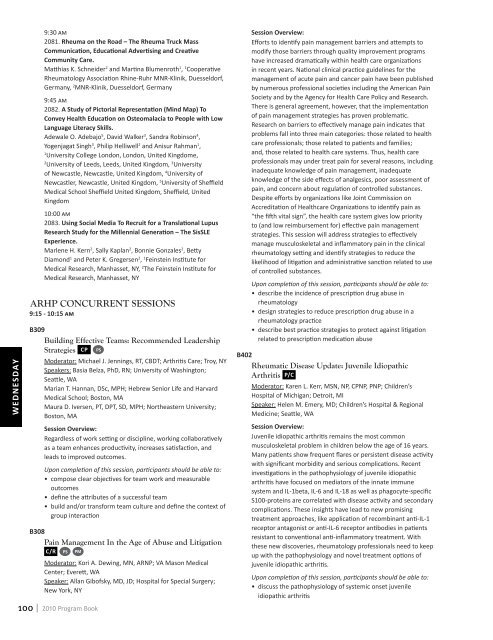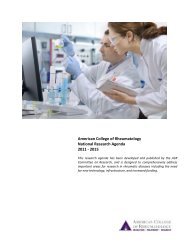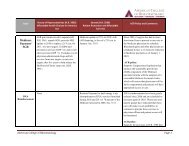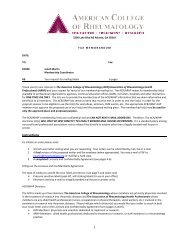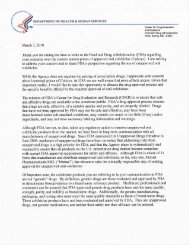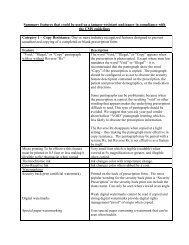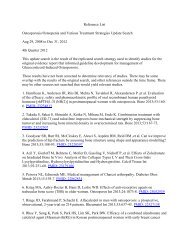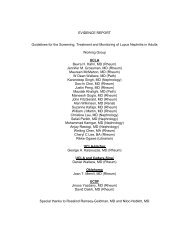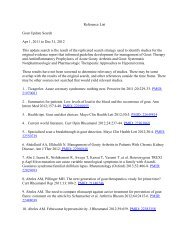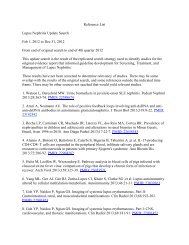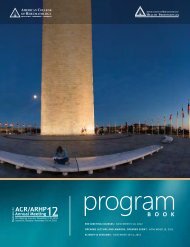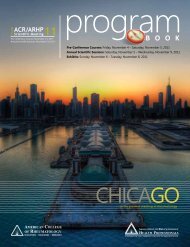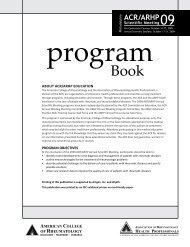B O O K - American College of Rheumatology
B O O K - American College of Rheumatology
B O O K - American College of Rheumatology
You also want an ePaper? Increase the reach of your titles
YUMPU automatically turns print PDFs into web optimized ePapers that Google loves.
wednesday<br />
100<br />
9:30 am<br />
2081. Rheuma on the Road – The Rheuma Truck Mass<br />
Communication, Educational Advertising and Creative<br />
Community Care.<br />
Matthias K. Schneider 2 and Martina Blumenroth 1 , 1 Cooperative<br />
<strong>Rheumatology</strong> Association Rhine-Ruhr MNR-Klinik, Duesseldorf,<br />
Germany, 2 MNR-Klinik, Duesseldorf, Germany<br />
9:45 am<br />
2082. A Study <strong>of</strong> Pictorial Representation (Mind Map) To<br />
Convey Health Education on Osteomalacia to People with Low<br />
Language Literacy Skills.<br />
Adewale O. Adebajo 5 , David Walker 3 , Sandra Robinson 4 ,<br />
Yogenjagat Singh 3 , Philip Helliwell 2 and Anisur Rahman 1 ,<br />
1<br />
University <strong>College</strong> London, London, United Kingdome,<br />
2<br />
University <strong>of</strong> Leeds, Leeds, United Kingdom, 3 University<br />
<strong>of</strong> Newcastle, Newcastle, United Kingdom, 4 University <strong>of</strong><br />
Newcastler, Newcastle, United Kingdom, 5 University <strong>of</strong> Sheffield<br />
Medical School Sheffield United Kingdom, Sheffield, United<br />
Kingdom<br />
10:00 am<br />
2083. Using Social Media To Recruit for a Translational Lupus<br />
Research Study for the Millennial Generation – The SisSLE<br />
Experience.<br />
Marlene H. Kern 2 , Sally Kaplan 2 , Bonnie Gonzales 2 , Betty<br />
Diamond 1 and Peter K. Gregersen 2 , 1 Feinstein Institute for<br />
Medical Research, Manhasset, NY, 2 The Feinstein Institute for<br />
Medical Research, Manhasset, NY<br />
ARHP Concurrent Sessions<br />
9:15 - 10:15 am<br />
B309<br />
Building Effective Teams: Recommended Leadership<br />
Strategies cP PS<br />
Moderator: Michael J. Jennings, RT, CBDT; Arthritis Care; Troy, NY<br />
Speakers: Basia Belza, PhD, RN; University <strong>of</strong> Washington;<br />
Seattle, WA<br />
Marian T. Hannan, DSc, MPH; Hebrew Senior Life and Harvard<br />
Medical School; Boston, MA<br />
Maura D. Iversen, PT, DPT, SD, MPH; Northeastern University;<br />
Boston, MA<br />
Session Overview:<br />
Regardless <strong>of</strong> work setting or discipline, working collaboratively<br />
as a team enhances productivity, increases satisfaction, and<br />
leads to improved outcomes.<br />
Upon completion <strong>of</strong> this session, participants should be able to:<br />
• compose clear objectives for team work and measurable<br />
outcomes<br />
• define the attributes <strong>of</strong> a successful team<br />
• build and/or transform team culture and define the context <strong>of</strong><br />
group interaction<br />
B308<br />
Pain Management In the Age <strong>of</strong> Abuse and Litigation<br />
c/r PS PM<br />
Moderator: Kori A. Dewing, MN, ARNP; VA Mason Medical<br />
Center; Everett, WA<br />
Speaker: Allan Gib<strong>of</strong>sky, MD, JD; Hospital for Special Surgery;<br />
New York, NY<br />
2010 Program Book<br />
Session Overview:<br />
Efforts to identify pain management barriers and attempts to<br />
modify those barriers through quality improvement programs<br />
have increased dramatically within health care organizations<br />
in recent years. National clinical practice guidelines for the<br />
management <strong>of</strong> acute pain and cancer pain have been published<br />
by numerous pr<strong>of</strong>essional societies including the <strong>American</strong> Pain<br />
Society and by the Agency for Health Care Policy and Research.<br />
There is general agreement, however, that the implementation<br />
<strong>of</strong> pain management strategies has proven problematic.<br />
Research on barriers to effectively manage pain indicates that<br />
problems fall into three main categories: those related to health<br />
care pr<strong>of</strong>essionals; those related to patients and families;<br />
and, those related to health care systems. Thus, health care<br />
pr<strong>of</strong>essionals may under treat pain for several reasons, including<br />
inadequate knowledge <strong>of</strong> pain management, inadequate<br />
knowledge <strong>of</strong> the side effects <strong>of</strong> analgesics, poor assessment <strong>of</strong><br />
pain, and concern about regulation <strong>of</strong> controlled substances.<br />
Despite efforts by organizations like Joint Commission on<br />
Accreditation <strong>of</strong> Healthcare Organizations to identify pain as<br />
“the fifth vital sign”, the health care system gives low priority<br />
to (and low reimbursement for) effective pain management<br />
strategies. This session will address strategies to effectively<br />
manage musculoskeletal and inflammatory pain in the clinical<br />
rheumatology setting and identify strategies to reduce the<br />
likelihood <strong>of</strong> litigation and administrative sanction related to use<br />
<strong>of</strong> controlled substances.<br />
Upon completion <strong>of</strong> this session, participants should be able to:<br />
• describe the incidence <strong>of</strong> prescription drug abuse in<br />
rheumatology<br />
• design strategies to reduce prescription drug abuse in a<br />
rheumatology practice<br />
• describe best practice strategies to protect against litigation<br />
related to prescription medication abuse<br />
B402<br />
Rheumatic Disease Update: Juvenile Idiopathic<br />
Arthritis P/C<br />
Moderator: Karen L. Kerr, MSN, NP, CPNP, PNP; Children’s<br />
Hospital <strong>of</strong> Michigan; Detroit, MI<br />
Speaker: Helen M. Emery, MD; Children’s Hospital & Regional<br />
Medicine; Seattle, WA<br />
Session Overview:<br />
Juvenile idiopathic arthritis remains the most common<br />
musculoskeletal problem in children below the age <strong>of</strong> 16 years.<br />
Many patients show frequent flares or persistent disease activity<br />
with significant morbidity and serious complications. Recent<br />
investigations in the pathophysiology <strong>of</strong> juvenile idiopathic<br />
arthritis have focused on mediators <strong>of</strong> the innate immune<br />
system and IL-1beta, IL-6 and IL-18 as well as phagocyte-specific<br />
S100-proteins are correlated with disease activity and secondary<br />
complications. These insights have lead to new promising<br />
treatment approaches, like application <strong>of</strong> recombinant anti-IL-1<br />
receptor antagonist or anti-IL-6 receptor antibodies in patients<br />
resistant to conventional anti-inflammatory treatment. With<br />
these new discoveries, rheumatology pr<strong>of</strong>essionals need to keep<br />
up with the pathophysiology and novel treatment options <strong>of</strong><br />
juvenile idiopathic arthritis.<br />
Upon completion <strong>of</strong> this session, participants should be able to:<br />
• discuss the pathophysiology <strong>of</strong> systemic onset juvenile<br />
idiopathic arthritis


